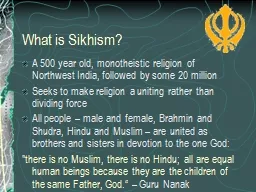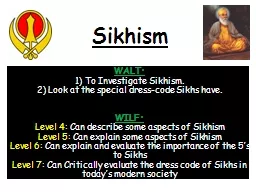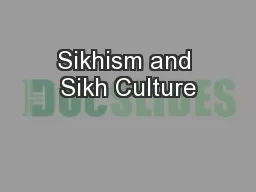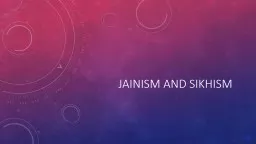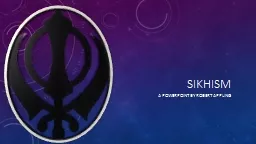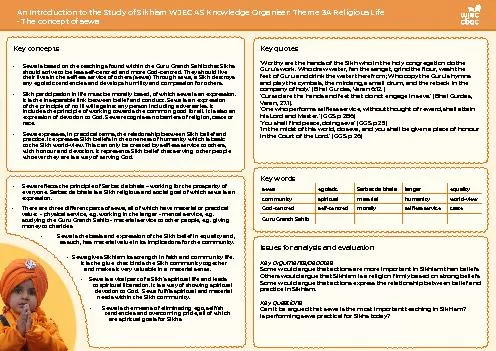PPT-What is Sikhism? Learning objectives
Author : giovanna-bartolotta | Published Date : 2018-11-02
To be able to understand the basic history of Sikhism To know what the five Ks are at the end of the lesson To understand what a Gurdwara is To understand the
Presentation Embed Code
Download Presentation
Download Presentation The PPT/PDF document "What is Sikhism? Learning objectives" is the property of its rightful owner. Permission is granted to download and print the materials on this website for personal, non-commercial use only, and to display it on your personal computer provided you do not modify the materials and that you retain all copyright notices contained in the materials. By downloading content from our website, you accept the terms of this agreement.
What is Sikhism? Learning objectives: Transcript
To be able to understand the basic history of Sikhism To know what the five Ks are at the end of the lesson To understand what a Gurdwara is To understand the main Rites of passenger of Sikhs. The founder of Sikhism was Guru Nanak. Guru Nanak was born in 1469 at Talwand (now called Nanakana Sahib) in what is now Pakistan. Guru means religi Guru Nanak’s teachings are recorded in the ho First encounter:. List the different topics you want to include . in . your PhD-course/activity that you . designed yesterday. -write them on a piece of paper. Look at the three competence objectives you just made with Bob for one of your topics. Objective: Conservation of energy. Yes. No. Depends on context. Does this learning goal focus on what the student will do?. Objective: Conservation of energy. Yes. No. Depends on context. Perhaps instead, . What is Bullying ?. Who are Sikhs ?. Why are Sikh Students . B. ullied ?. What to do if you are Bullied ?. What to do if you see someone being Bullied ?. You might be bullying if…. Table of Contents. A 500 year old, monotheistic religion of Northwest India, followed by some 20 million. Seeks to make religion a uniting rather than dividing force. All people – male and female, Brahmin and Shudra, Hindu and Muslim – are united as brothers and sisters in devotion to the one God:. WALT: . 1) To Investigate Sikhism.. 2) Look at the special dress-code Sikhs have.. WILF:. Level 4: . Can describe some aspects of Sikhism. Level 5: . Can explain some aspects of Sikhism. Level 6: . Can explain and evaluate the importance of the 5’s to Sikhs. HCOM 301- Kierstin Anderson, Chris Holle, Karem Celaya, Gerardo Santiago. Background Context. Originate from India . 23,000,000 followers today.. Headquarters in Amritsar, Punjab, India.. Traced to Guru Nanak. Religions of India. Aside from Hinduism and Buddhism, what traditions exist in India?. Jainism. Jainism Overview. Jains are followers of the . Jinas. , “spiritual conquerors”. Jinas. are also known as . Marie C. Day . & Michael W. . Wilson. Valdosta State University. Abstract. This . presentation . introduces . the ABCD method of writing learning . objectives . and . provides . examples applicable to information literacy sessions. Participants will learn the four elements to include in every objective. INTRODUCTION. Khalsa –created by Guru Gobind Singh Ji, the 10. th. Guru of the Sikhs.. In the year1699 at Anandpur Sahib on Baisakhi day.. The sikhs were now called Singhs.. SYMBOLS OF KHALSA. Kesh- Different looks.. Origins of Sikhism. Sikhism originated in the Punjab region of the Indian Subcontinent, near modern day Pakistan. It was founded by Guru Nanak, a Hindu who took a different approach to religion and founded a new one based off of Hinduism and Islam.. Education Model: Levels, Modalities, and Objectives Goal ZI becomes the recognized industry leader in effectively meeting the orthopaedic learning needs of HCPs by 2018. Starting with ZI’s Why SS Maximize Confidence to Optimize Performance • Sewa is based on the teachings found within the Guru Granth Sahib that Sikhs should strive to be less self-centred and more God-centred. They should live their lives in the sel�ess Islam in the United States. Information adapted from the Pluralism Project. Left: Sikh gurdwara in Freemont, CA; Right: Mosque in Boston, MA. Punjabi Sikh immigrants began arriving in the early 1900s. Muslim Bangladeshi immigrants began arriving to the United States in the late 1800s. .
Download Document
Here is the link to download the presentation.
"What is Sikhism? Learning objectives"The content belongs to its owner. You may download and print it for personal use, without modification, and keep all copyright notices. By downloading, you agree to these terms.
Related Documents





